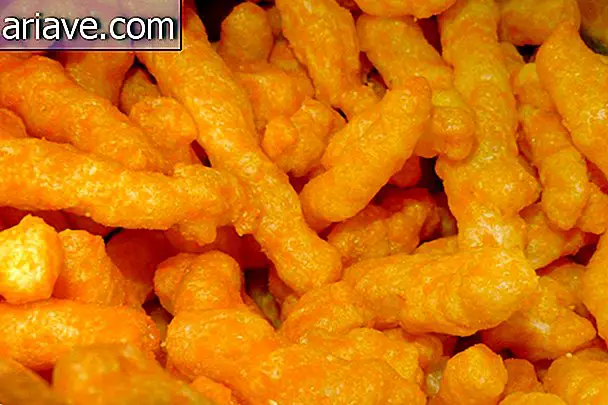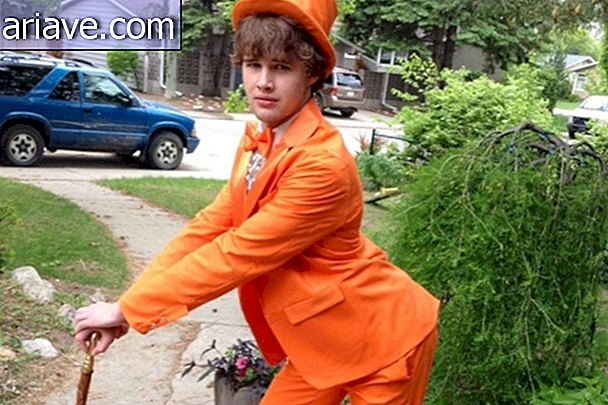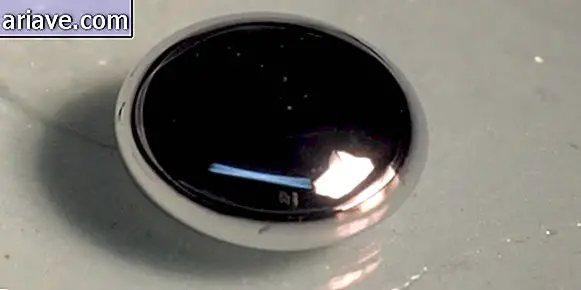10 intriguing things astronauts took to the moon
Twelve astronauts landed on the moon between 1969 and 1972 on Apollo 11 to 17 missions. They took various essentials for their survival on their travels, but also carried some unusual things to the moon. Check out below what they were.
10 - Hawk and Hammer Feather
Galileo theorized that heavy and light objects would fall at the same speed when there was no air resistance. On the moon it has no air and therefore does not suffer from its resistance, being a great place to demonstrate the principle of Galileo.
For this reason, Apollo 15 astronaut David Scott decided to experiment. He dropped a hammer and feather of the same height, and the objects fell at the same time.
You can check out the experiment in the video above, where Scott says, "This is a hawk feather, for our Falcon ...". It refers to the lunar module that also bore the name of Falcon, as the crew had connections with the United States Air Force Academy, which has the falcon as a symbol.
9 - Host and wine

It was not publicized at the time, but Apollo 11 astronaut Buzz Aldrin took communion to the moon. Aldrin was an active practitioner of his Presbyterian church at the time and asked his pastor how he might mark the occasion of the first humans landing on Earth. Moon in a religious way.
The shepherd then prepared a wafer and a small bottle of wine, which Aldrin took with him into space. A few minutes after landing on the moon, he made a public statement on the radio communicator, telling the people who were listening to stop for a moment and give thanks for what was happening.
Then Aldrin stopped radio communication with Earth to perform the religious space ceremony. He took the wafer out of the plastic bag, poured the wine into a small chalice that his church had given him, and read a verse from John's gospel (which was in a notebook). Then he sipped the host and the wine in prayer.
Aldrin wanted to broadcast the verse on the radio, but NASA urged him to refrain from this attitude because of a previous incident. When Apollo 8 astronauts read a portion of Genesis while orbiting the moon at Christmas, the agency had faced a lawsuit. But despite this, NASA did not try to keep the Aldrin communion secret.
8 - Oregon Lava

NASA trained astronauts for moonwalks and lunar ground operations, sending them to practice in places on Earth that were somewhat similar to the surface of the moon. Bend, Oregon, approached the characteristics, so that astronauts spent a lot of time there in training.
In 1966, one of the astronauts in Bend was James Irwin. There he met a local resident who was like a NASA contract host named Floyd Watson.
Five years later, when Watson heard that Irwin had been selected to land on the moon with Apollo 15, he wrote him asking a favor: "I'm sending you a small sliver of lava from Central Oregon lava that I hope you will be able to." take me to the moon. I have five grandchildren who will be forever grateful to you, "the letter said.
Then, shortly after the Apollo 15 crew returned to Earth, Watson received a letter from Irwin stating that he not only carried the chip but had left it on lunar soil. The astronaut sent a picture of where he left the chip with a dedication: “To Floyd Watson. Oregon Lava on the Moon! Cheers. Jim Irwin ".
7 - Pieces of a 1930s plane

The Wright brothers, the aviation pioneers, were from Ohio. The Apollo 11 astronaut, the famous Neil Armstrong, was also from this US state. He carried several items to the moon and, as a tribute to his countrymen, he also carried a piece of the brothers' historic Wright Flyer .
In a special deal with the US Air Force Museum, he carried in his lunar module a piece of wood from the left propeller and a piece of cloth from the upper left wing of the 1903 plane. Armstrong brought the pieces back to Terra and they are on display at the Wright Brothers National Memorial near Kitty Hawk, North Carolina.
6 - A University of Michigan sign

All three Apollo 15 astronauts (David Scott, Alfred Worden and James Irwin) studied at the University of Michigan. So they decided to pay tribute during their mission by founding a University of Michigan Moon-based association. As proof of the initiative, they left a small sign reading: "University of Michigan Alumni Association "
It is rumored that a University flag would also have been set on the moon. In fact, the team carried flags on the mission, but the only one spread on lunar soil was the US flag. The others were returned on return.
5 - Postcard

Did you know that Apollo 11 astronauts brought 214 postcards to the moon, which they "autographed"? For years, some cards signed by Aldrin and Collins surfaced for sale, but Armstrong kept all the cards for him.
Other Apollo crews carried postcards to the moon, but the Apollo 15 crew managed to create a scandal. They carried 243 unauthorized cards and 398 unauthorized stamps. The cards were supplied by a German collector named Hermann Sieger, who ran out of 100 of the cards when they returned from the moon.
Sieger sold everything immediately, even after astronauts warned him to wait until the Apollo program was over. When word of Sieger's sales spread, Congress questioned and NASA took disciplinary action. It was a fiasco.
4 - Brooches

Some of Apollo's astronauts carried brooches to the moon from those who put on lapels in suits or uniforms. Some were left on the moon and others were brought back. One that was left by the Apollo 11 mission shows an eagle carrying an olive branch, which is a traditional symbol of peace.
Perhaps not coincidentally, the moon module of Apollo 11, which landed on the moon, was named Eagle. Another who wanted to leave a memory on the moon was astronaut Alan Bean of the Apollo 12 mission. Shortly after landing on the moon, Bean took his silver brooch and then reported:
“I took off my silver brooch, took one last look at it and threw it as hard as I could. I still remember how it shone in the sunlight then disappeared into the distance. "
3 - Family photo of an astronaut

Another thing astronauts liked to take to the moon was family photos. Perhaps most famous is the one that Apollo 16 astronaut Charles Duke left on the lunar surface. The photograph shows Duke, his wife Dorothy and their two sons, Charles and Thomas, sitting on a bench.
The back of the photo had the message: "This is the family of astronaut Duke of Planet Earth. It landed on the moon in April 1972." Below that message were the signatures of his wife and children. The photo was properly wrapped in clear plastic and shortly after placing it on the ground, Duke recorded the photo on the moon with another photo, which you see above.
2 - Two golf balls and a putter
Alan Shepard was the first American to travel to space. He was also one of the Apollo 14 astronauts, and during his second extra-vehicular activity (EVA) he revealed that he had brought two golf balls and a club to the moon.
According to what Shepard reported on the first try: "Unfortunately, the suit is so rigid that I can't do it with both hands, but I'll try." He said the first shot made more dirt fly than ball. the second moved the ball about five feet and the third moved the ball in a short arc.
He then made a move that sent the ball far away. The golf balls used in the game remained on the moon, but the club returned to Earth and is on display at the USGA Museum in New Jersey. You can watch the moves in the video above.
1 - Small message disc

One of the things Armstrong and Aldrin were supposed to leave on the moon's surface was a coin-sized disc of fifty cents, but they almost forgot. On this tiny disc were written messages, but so small that a microscope was needed to read them.
It was a collection of peace messages from personalities from 73 countries, including Queen Elizabeth II, Indira Gandhi, Pope Paul VI, and other leaders. The diskette was designed and produced with material to last thousands of years on the lunar surface.
* Posted on 11/06/2014











